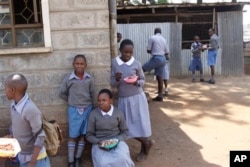More girls are completing secondary school across sub-Saharan Africa as attitudes change and state spending rises, but some of the most marginalized girls — like those married young or forced to work — are still missing out, education experts say.
The percentage of girls completing secondary school has risen in all regions of Africa since 2005, said a recent report by the African Development Bank, the Organization for Economic Cooperation and Development, and the U.N. Development Program.
Almost twice as many girls in East Africa and three times as many in Central Africa completed secondary education in 2014 as in 2005, according to the annual African Economic Outlook report, which was published at the end of last month.
Yet more must be done to support girls across the continent who are not in school if the world is to meet a U.N. global goal to ensure all children receive secondary schooling by 2030, experts say.
The deadline on universal education was agreed as part of the Sustainable Development Goals (SDGs) — a global plan to end poverty and hunger, advance equality and protect the environment.
"Many of the most marginalized girls from the poorest households do not make the transition from primary to secondary, or ever set foot in a school at all," Paola Babos of the U.N. children's agency (UNICEF) told Reuters.
Attitudes toward education for girls are changing across Africa — as more and more parents see sending their daughters to school not only as a chance to improve their futures, but also to boost the family's fortunes, according to Plan International.
Yet issues such as child marriage and teenage pregnancy threaten progress in closing the education gender gap in sub-Saharan Africa, said Vernor Munoz, an education expert at Plan.
"We need to look beyond education to society — and tackle prejudices, stereotypes and harmful practices that prevent girls being in school," Munoz told Reuters.
While the gender education gap is closing on the continent, of 19 countries worldwide with fewer than 90 girls for every 100 boys in secondary school, two-thirds of them are in sub-Saharan Africa, according to the U.N. educational body UNESCO.
The world is set to miss by more than half a century the SDG on education due to under-funding, UNESCO said last September.
Yet African governments have scaled up spending on education in recent years, found the African Economic Outlook report.
The average percentage of state expenditure on education in sub-Saharan Africa between 2010 and 2014 was 16 percent, higher than the global average of 14 percent, the report showed.







